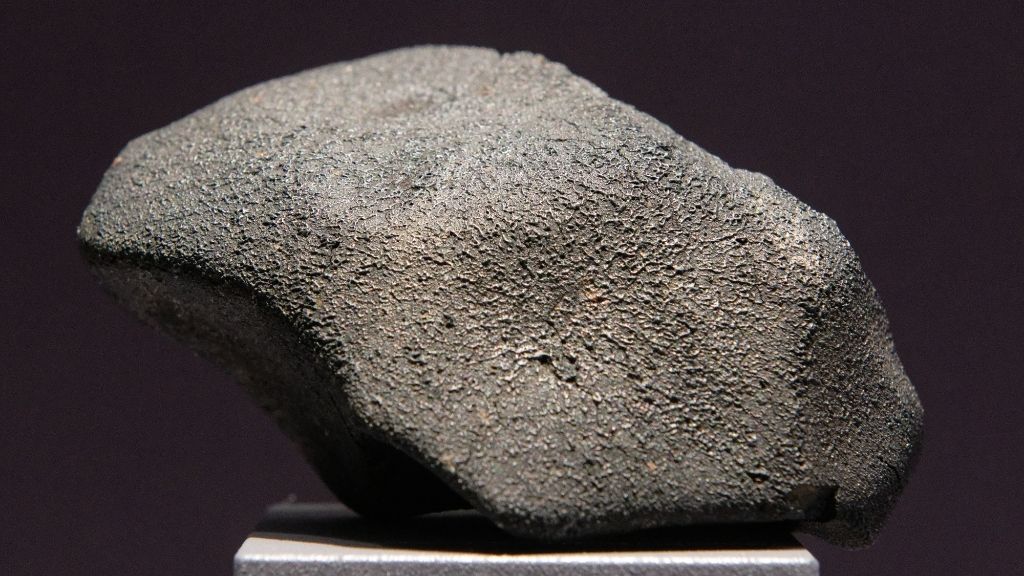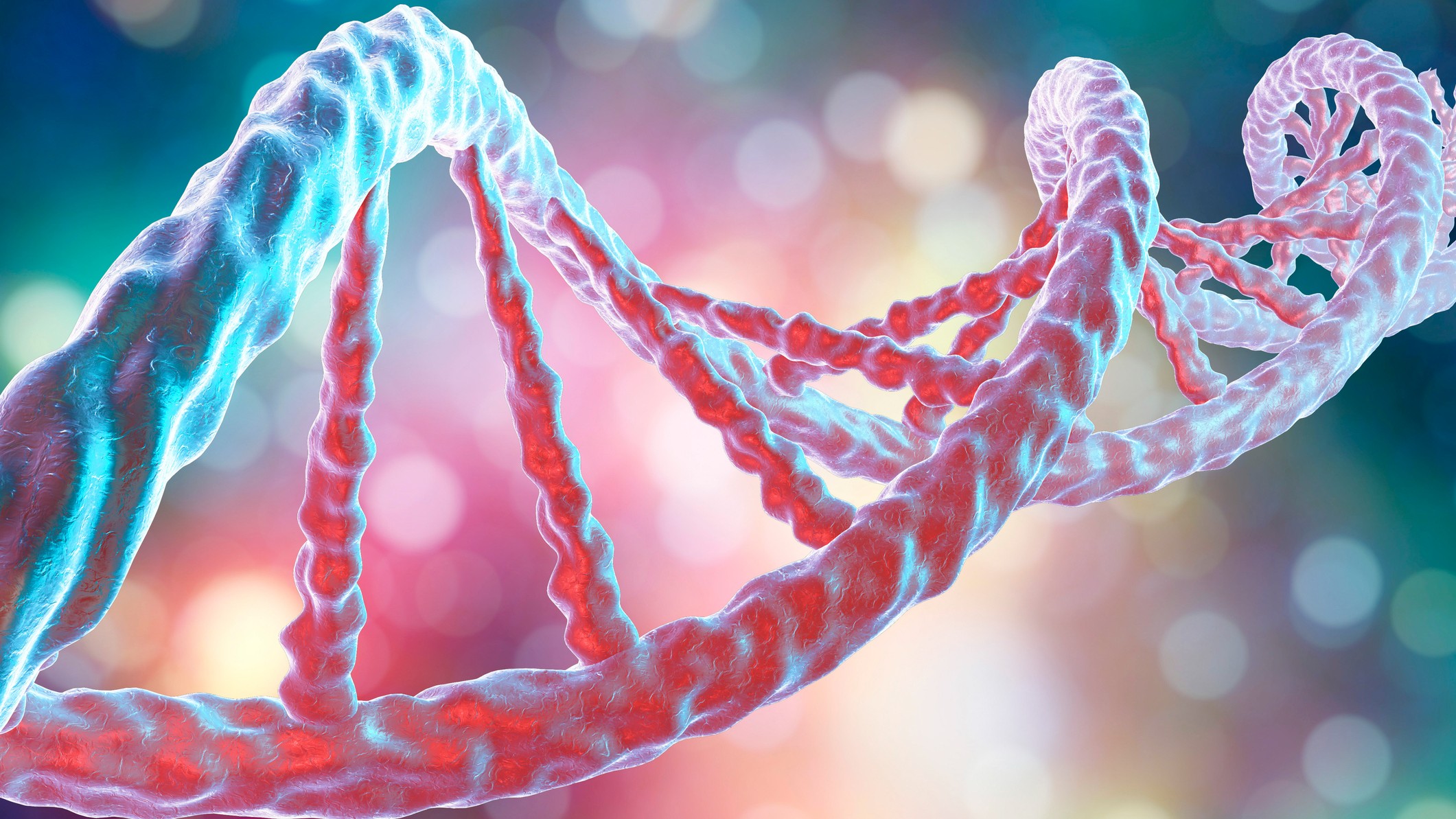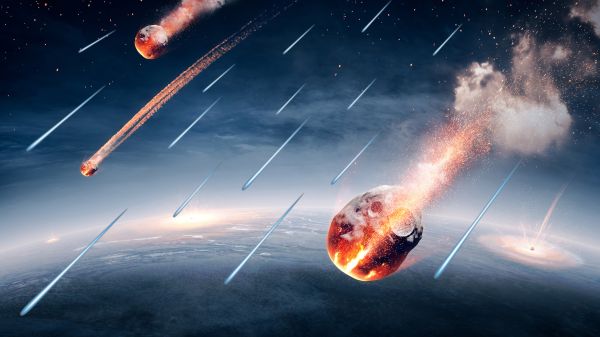These meteorites contain all of the building blocks of DNA
Scientists found DNA and RNA components in meteorites.

Three meteorites contain the molecular building blocks of DNA and its cousin RNA, scientists recently discovered. A subset of these building blocks had been detected in meteorites before, but the rest of the collection seemed mysteriously absent from space rocks — until now.
The new discovery supports the idea that, some four billion years ago, a barrage of meteorites may have delivered the molecular ingredients needed to jump-start the emergence of the earliest life on Earth, the researchers say.
However, not everyone is convinced that all of the newfound DNA components are extraterrestrial in origin; rather, some may have ended up in the meteorites after the rocks touched down on Earth, said Michael Callahan, an analytical chemist, astrobiologist and associate professor at Boise State University who was not involved in the study. "Additional studies are needed" to rule out this possibility, Callahan told Live Science in an email.
Assuming that all of the compounds did originate in space, one subset of building blocks — a class of compounds known as pyrimidines — appeared in "extremely low concentrations" in the meteorites, he added. This finding hints that the world's first genetic molecules emerged not due to an influx of DNA components from space but rather as a result of the geochemical processes unfolding on early Earth, he said.
For now, though, "it's hard to say" what concentration of DNA building blocks meteorites would have needed to contain to help drive the emergence of life on Earth, said Jim Cleaves, a geochemist and president of the International Society for the Study of the Origin of Life, who was not involved in the study. This question remains under investigation.
Related: 7 theories on the origin of life
Life's building blocks in space rocks

Components of DNA and RNA have been found in meteorites before, Live Science previously reported. Specifically, such space rocks have been found to contain nucleobases, the nitrogen-containing compounds that serve as the "letters" in the genetic code of our DNA and RNA. Nucleobases come in five primary flavors — adenine (A), thymine (T), guanine (G), cytosine (C) and uracil (U) — but previously, only A, G and U had ever been identified in meteorites.
Get the world’s most fascinating discoveries delivered straight to your inbox.
Now, in a study published Tuesday (April 26) in the journal Nature Communications, scientists reported finding all five nucleobases inside carbon-rich meteorites. This included trace amounts of all three pyrimidines: cytosine, uracil and thymine. "In particular, the detection of cytosine is of surprise," because cytosine is relatively unstable and likely to react with water, said Yasuhiro Oba, an associate professor at the Institute of Low Temperature Science at Hokkaido University in Japan and first author of the study.
Although thymine and cytosine hadn't been found in meteorites before, laboratory studies hinted that these nucleobases might be lurking, undetected, in the space rocks that slammed into Earth.
For example, in lab settings, scientists have recreated the chemical conditions of interstellar space — the space between stars — where immense clouds of gas and dust measure about 10 kelvins (minus 441.67 degrees Fahrenheit, or minus 263.15 degrees Celsius) and the parent asteroids of meteorites can be found. Through these experiments, researchers synthesized thymine, cytosine and the other primary nucleobases, suggesting that all of these compounds could theoretically be detectable in meteorites, the study authors noted in their report.
Related: This may be life's 'missing ingredient'
So the team went hunting for these nucleobases in three well-known meteorites. "Murchison, Murray and Tagish Lake meteorites belong to a class of meteorites called carbonaceous chondrites, which are known to contain lots of organic compounds," Callahan said.
For example, hydrocarbons and the building blocks of proteins (amino acids) had been identified in the three meteorites, Oba said. Additionally, in previous work, Oba and his colleagues detected an elusive molecule called hexamethylenetetramine (HMT), which is thought to be an important precursor to organic molecules, in the space rocks, according to NASA.
In their latest study, the researchers used a technique called high-performance liquid chromatography, which involved using pressurized water to separate the meteorite samples into their component parts. In this way, the team extracted the nucleobases from each sample and then analyzed the bases using mass spectrometry, a technique that revealed the chemical makeup of the material in fine detail. This method "enabled us to detect nucleobases with very low concentrations, as low as parts per trillions," Oba told Live Science.
The analysis revealed that all of the meteorites carried adenine and guanine. The Murchison samples also contained uracil, while the other meteorites carried at least one uracil isomer, meaning a compound that contains the same number and types of atoms as uracil but in a different spatial arrangement. In addition, the Murchison and Tagish Lake samples carried thymine, and the Murray meteorite contained thymine isomers. All of the meteorites contained cytosine, along with various isomers of the compound.
Still uncertainty

To check that the nucleobases were extraterrestrial in origin rather than the result of Earthly contamination, the team repeated the experimental procedures without any meteorite material in the test chambers. No nucleobases were detected during these so-called blank experiments.
The team also had access to soil samples from the site where the Murchison meteorite first plummeted to Earth. They detected some nucleobases in the soil, but "their distribution and concentrations are clearly different from those found in meteorites," Oba said. In addition, some specific isomers appeared only in the meteorites and not in the soil sample; these "odd isomers" are rarely seen on Earth and are therefore unlikely to be contaminants from the planet's surface, Cleaves said.
By comparing the diversity of nucleobases found in the meteorite against that found in the soil, the team concluded that the compounds in the space rock formed in space, Oba said. And because of this, they expect that the nucleobases "contributed to the emergence of genetic properties for the earliest life on Earth," the authors wrote.
However, on these points, there's still some uncertainty, Callahan said.
Related: DNA just one of more than 1 million possible 'genetic molecules,' scientists find
The soil sample analyzed by the researchers contained higher concentrations of cytosine, uracil and thymine than they'd found in the Murchison meteorite, "so it's difficult to determine how much is extraterrestrial versus terrestrial in the meteorite," Callahan said. Moreover, the team didn't identify a specific chemical process that would produce C, U, T and their various isomers; such an analysis could have supported the idea that all of the compounds formed in interstellar space.
Another way to determine whether the nucleobases actually hail from space is to examine what forms of carbon and nitrogen they contain, Cleaves told Live Science. These elements come in different flavors, called isotopes, which contain the same numbers of protons but different numbers of neutrons. Earth matter contains different ratios of carbon isotopes and nitrogen isotopes than matter from space, so such analyses could help discriminate the terrestrial nucleobases from extraterrestrial ones, Callahan said. Unfortunately, such experiments require a fair amount of meteorite material to run and can, therefore, be difficult to execute, Cleaves said.
In any case, even if the detected C, T and U are extraterrestrial, their scant presence in the meteorites casts doubt on the theory that the first life on Earth was seeded by DNA components from space, Callahan said. "If these results are representative of typical pyrimidine concentrations in meteorites, then geochemical synthesis on early Earth would likely have been responsible for the emergence of genetic material, rather than inputs from extraterrestrial delivery," he said.
In the future, Oba and his colleagues plan to hunt for nucleobases in material collected directly from asteroids, rather than from meteorites on Earth, Oba told Live Science; this could minimize the issue of Earth-born contaminants. For example, the Japanese spacecraft Hayabusa2 recently brought the asteroid Ryugu down to Earth, Live Science previously reported, and NASA's OSIRIS-REx probe is due to touch down with samples of the near-Earth asteroid Bennu in 2023, according to Space.com.
Originally published on Live Science.

Nicoletta Lanese is the health channel editor at Live Science and was previously a news editor and staff writer at the site. She holds a graduate certificate in science communication from UC Santa Cruz and degrees in neuroscience and dance from the University of Florida. Her work has appeared in The Scientist, Science News, the Mercury News, Mongabay and Stanford Medicine Magazine, among other outlets. Based in NYC, she also remains heavily involved in dance and performs in local choreographers' work.


